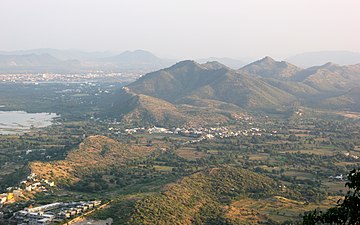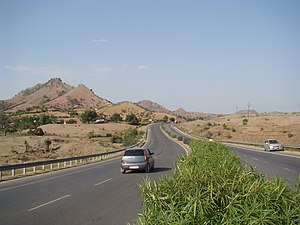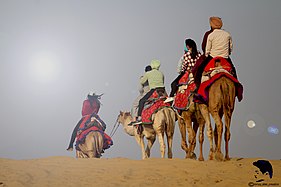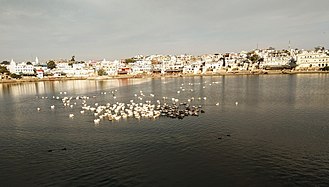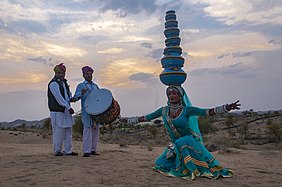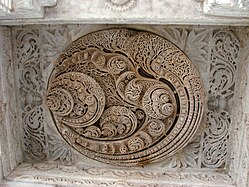Rajasthan
Rajasthan | ||
|---|---|---|
Amer Fort | ||
|
Emblem of Rajasthan | ||
| Etymology: Land of Kings | ||
| Motto(s): (Truth alone triumphs) | ||
Formation | 30 March 1949 | |
BJP ) State Legislature | Unicameral | |
| • Assembly | Rajasthan Legislative Assembly (200 seats) | |
| National Parliament | Parliament of India | |
| • Rajya Sabha | 10 seats | |
| • Lok Sabha | 25 seats | |
| High Court | Rajasthan High Court | |
| Area | ||
| • Total | 342,239 km2 (132,139 sq mi) | |
| • Rank | Emblem of Rajasthan | |
| Bird | Godawan | |
| Flower | Rohida | |
| Mammal | Camel and Chinkara[11] | |
| Tree | Khejri | |
| State highway mark | ||
 | ||
| State highway of Rajasthan RJ SH1 -RJ SH138 | ||
| List of Indian state symbols | ||
Rajasthan (Hindi:
Its major features include the ruins of the
The State of Rajasthan was formed on 30 March 1949 when the states of the
Etymology
Rajasthan means "The Land of Kings" and is a portmanteau of Sanskrit "Rājā" ('King') and Sanskrit "Sthāna" ('Land') or Persian "St(h)ān", with the same meaning.[12] The oldest reference to Rajasthan is found in a stone inscription dated back to 625 CE.[18] The first printed mention of the name Rajasthan appears in the 1829 publication Annals and Antiquities of Rajasthan or the Central and Western Rajpoot States of India, while the earliest known record of Rajputana as a name for the region is in George Thomas's 1800 memoir Military Memories.[19] John Keay, in his book India: A History, stated that Rajputana was coined by the British in 1829, John Briggs, translating Ferishta's history of early Islamic India, used the phrase "Rajpoot (Rajput) princes" rather than "Indian princes".[20]
History
Ancient times
Parts of what is now Rajasthan were partly part of the
A archaeological excavation at the Balathal site in Udaipur district shows a settlement contemporary with the Harrapan civilisation dating back to 3000–1500 BCE. Stone Age tools dating from 5,000 to 200,000 years were found in Bundi and Bhilwara districts of the state.[23]
The
Bhargava
The
Classical era
Gurjara-Pratihara
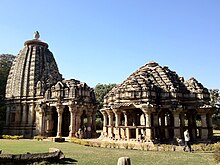
The Pratiharas ruled for many dynasties in this part of the country; the region was known as
The
Medieval and early modern eras
SULTANATE
The
The Rajputs put up resistance to the Islamic invasions with their warfare and chivalry for centuries. The Ranas of Mewar led other kingdoms in their resistance to outside rule. Rana
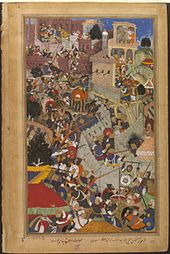
During Akbar's reign most of the Rajput kings accepted Mughal suzerainty, but the rulers of Mewar (Rana Udai Singh II) and Marwar (Rao Chandrasen Rathore) refused to have any form of alliance with the Mughals. To teach the Rajputs a lesson Akbar attacked Udai Singh and killed Rajput commander Jaimal of Chitor and the citizens of Mewar in large numbers. Akbar killed 20,000–25,000 unarmed citizens in Chittor on the grounds that they had actively helped in the resistance.[43]
Maharana Pratap took an oath to avenge the citizens of Chittor; he fought the Mughal empire till his death and liberated most of Mewar apart from Chittor itself. Maharana Pratap soon became the most celebrated warrior of Rajasthan and became famous all over India for his sporadic warfare and noble actions. According to Satish Chandra, "Rana Pratap's defiance of the mighty Mughal empire, almost alone and unaided by the other Rajput states, constitutes a glorious saga of Rajput valor and the spirit of self-sacrifice for cherished principles. Rana Pratap's methods of sporadic warfare were later elaborated further by Malik Ambar, the Deccani general, and by Shivaji".[44]
Rana
During Aurangzeb's rule Rana Raj Singh I and Veer Durgadas Rathore were chief among those who defied the intolerant emperor of Delhi. They took advantage of the Aravalli hills and caused heavy damage to the Mughal armies that were trying to occupy Rajasthan.[46][47]
After Aurangzeb's death
Over the years, the Mughals began to have internal disputes which greatly distracted them at times. The Mughal Empire continued to weaken, and with the decline of the Mughal Empire in the late 18th century, Rajputana came under the influence of the Marathas. The Maratha Empire, which had replaced the Mughal Empire as the overlord of the subcontinent, was finally replaced by the British Empire in 1818.[50]
In the 19th century, the Rajput kingdoms were exhausted, they had been drained financially and in manpower after continuous wars and due to heavy tributes exacted by the Maratha Empire. To save their kingdoms from instability, rebellions and banditry the Rajput kings concluded treaties with the British in the early 19th century, accepting British suzerainty and control over their external affairs in return for internal autonomy.[51]
-
Rana Kumbha was the vanguard of the fifteenth century Rajput resurgence.[52]
-
The emperor Hemu, who rose from obscurity and briefly established himself as ruler in northern India, from Punjab to Bengal, in defiance of the warring Sur and Mughal Empires.
-
Durgadas Rathore, a Rathore Rajput warrior of Jodhpur who played an important role in protecting the Rathore dynasty of Marwar and for his rebellion against Aurangzeb.
-
Maharana Pratap Singh, sixteenth-century Rajput ruler of Mewar, known for his defence of his realm against Mughal invasion.
Modern era
The State of Rajasthan was formed on 30 March 1949 when the states of the
Geography
The geographic features of Rajasthan are the Thar Desert and the Aravalli Range, which runs through the state from southwest to northeast, almost from one end to the other, for more than 850 kilometres (530 mi).[57] Mount Abu lies at the southwestern end of the range, separated from the main ranges by the West Banas River.[58] Although a series of broken ridges continues into Haryana in the direction of Delhi where it can be seen as outcrops in the form of the Raisina Hill and the ridges farther north. About three-fifths of Rajasthan lies northwest of the Aravallis, leaving two-fifths on the east and south direction.

The Aravalli Range runs across the state from the southwest peak
The Aravalli Range and the lands to the east and southeast of the range are generally more fertile and better watered. This region is home to the
The northwestern portion of Rajasthan is generally sandy and dry. Most of this region is covered by the Thar Desert which extends into adjoining portions of Pakistan. The Aravalli Range does not intercept the moisture-giving southwest monsoon winds off the Arabian Sea, as it lies in a direction parallel to that of the coming monsoon winds, leaving the northwestern region in a rain shadow. The Thar Desert is thinly populated; the City of Jodhpur is the largest city in the desert and a major metropolitan area of India which is known as the gateway of the Thar desert. The desert has some major districts like Jodhpur, Jaisalmer, Barmer, Bikaner, and Nagaur. This area is also important from a defence point of view. Jodhpur airbase is one of the largest airbases in India, BSF and Military bases are also situated here. Currently four civil airports are located here: Jodhpur, Jaisalmer, Bikaner and Nagaur, of which Jodhpur is the major civil airport, being the 44th busiest airport in India and one of the oldest air strips of India, being built in the 1920s.
The
-
Mount Abu is a popular hill station in Rajasthan.
-
The Thar Desert near Jaisalmer.
-
Aerial view Udaipur and Aravali hills.
Flora and fauna
| Formation day | 1 November |
| State animal | Chinkara[60] and camel[61] |
| State bird | Godavan (great Indian bustard)[60] |
| State flower | Rohida[60]
|
| State tree | Khejri[60] |
The
The Ranthambore National Park located in Sawai Madhopur,[64] one of the well known tiger reserves in the country, became a part of Project Tiger in 1973.
Wildlife protection

Rajasthan is also noted for its national parks and
Governance and administration

The state is governed by a parliamentary system of representative democracy. The governor serves as the state's constitutional leader, whereas the chief minister assumes the role of both the head of the government and the head of the council of ministers. The Legislative Assembly consists of 200 members who are elected for five-year terms. The state contributes 25 seats to Lok Sabha, the lower house of the Indian Parliament, and 10 seats to Rajya Sabha, the upper house.[68][69]
The
For the administration purpose, the state is divided into 10 divisions and 50 districts.

Rajasthan has its High court Jodhpur which has its principal seat at Jodhpur and a bench at Jaipur, with district courts and session courts in each district or Sessions Division, and lower courts at the tehsil level.[71] The president of India appoints the chief justice of the High Court of Rajasthan judiciary on the advice of the Chief Justice of the Supreme Court of India as well as the governor of Rajasthan. In Rajasthan, the Subordinate Judicial Service is an essential component of the state's judiciary, and it is divided into two categories: the Rajasthan Civil Judicial Services and the Rajasthan Higher Judicial Service.[72] The former includes Civil Judges (Junior Division)/Judicial Magistrates and Civil Judges (Senior Division)/Chief Judicial Magistrate. On the other hand, the latter consists of Civil and Sessions Judges. The District Judge has control over the Subordinate Judicial Service in Rajasthan.
The politics of Rajasthan has mainly been dominated mainly by the Bharatiya Janata Party and the Indian National Congress.
Chief Secretary Of Rajasthan is Usha Sharma[73] and Director General of Police or DGP of Rajasthan is Umesh Mishra.[74]
Divisions, districts and cities
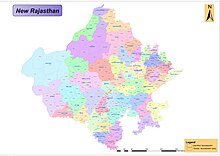

Rajasthan is composed of the following geographical regions:
Rajasthan is divided into 50 districts within Ten
Division
|
Districts
|
|---|---|
| Jaipur |
|
| Jodhpur |
|
| Ajmer |
|
| Udaipur |
|
| Bikaner |
|
| Kota |
|
| Bharatpur | |
| Sikar | Sikar, Jhunjhunu, Neem ka thana, Churu |
| Pali | Pali, Sirohi, Jalore, Sanchore |
| Banswara | Banswara, Dungarpur, Pratapgarh |
A
Communication
Major internet service provider (ISP) and telecom companies are present in Rajasthan including
Economy

Rajasthan's economy is primarily agricultural and

The main industries are mineral based, agriculture-based, and
Rajasthan also has reserves of low-silica limestone.[78]
Rajasthan connected 100% of its population to electricity power in 2019 (raising the rate of electricity access from 71% of the population in 2015).[79] The renewable energy sector plays the most important role in the increase of generation capacities, with the main focus on solar energy. In 2020, Bhadla Solar Park was recognised as the largest cluster of photovoltaic power plants in a single region in the world, with the installed power exceeding the 2.2 gigawatt peak.
Transportation
The state is served by a substantial road network, providing links between urban centers, agricultural market-places and rural areas. There are 33
-
Maharajah's Express dining saloon
-
The Jaipur Metro is an important urban transportation link
Demographics
| Year | Pop. | ±% p.a. |
|---|---|---|
| 1901 | 10,294,090 | — |
| 1911 | 10,983,509 | +0.65% |
| 1921 | 10,292,648 | −0.65% |
| 1931 | 11,747,974 | +1.33% |
| 1941 | 13,863,859 | +1.67% |
| 1951 | 15,970,774 | +1.42% |
| 1961 | 20,155,602 | +2.35% |
| 1971 | 25,765,806 | +2.49% |
| 1981 | 34,261,862 | +2.89% |
| 1991 | 44,005,990 | +2.53% |
| 2001 | 56,507,188 | +2.53% |
| 2011 | 68,548,437 | +1.95% |
| source:[85] | ||
According to the
Brahmins, according to
| City | Population |
|---|---|
| Jaipur | 3,073,349
|
| Jodhpur | 1,138,300
|
| Kota | 1,001,694
|
| Bikaner | 647,804
|
| Ajmer | 551,101
|
| Udaipur | 474,531
|
| Bhilwara | 360,009
|
| Alwar | 341,422
|
| Bharatpur | 252,838
|
| Sri Ganganagar | 249,914
|
Language
Hindi is the official language of the state, while English is the additional official language.[15]
The languages of Rajasthan primarily belong to the Rajasthani group of Indo-Aryan languages, which most people regard as their own language. In the north are dialects of Punjabi and Bagri, which is a transition between Rajasthani and Punjabi. In the northeast Shekhawati and Dhundari are spoken which gradually merge with Haryanvi. In the east Mewati is spoken in the Mewat region, while in the far east Braj is spoken.[96] To the southeast Haryanvi is spoken. To the west in the heart of the Thar Desert Marwari is spoken, which merges to Gujarati in the southwest. In the south, in the Mewar region, Mewari is spoken, while in the hills of Wagad, Wagdi, a Bhil language, is spoken. Many speakers of Rajasthani languages refer to their language as Hindi, and Standard Hindi is the medium of education and is common in cities. Urdu is also common in cities although the vast majority of Muslims speak one of the Rajasthani languages as their first language. Sindhi is also common in the cities and along the border with Sindh in Pakistan where Dhatki, a transition between Marwari and Sindhi, is the main dialect on both sides of the border.[citation needed]
The languages taught under the three-language formula are:[97]
- First language: Hindi
- Second language: English
- Third language: Gujarati, Punjabi, Sanskrit, Sindhi or Urdu
Culture
| Part of a series on |
| Rajasthani people |
|---|
| Culture |
| Religion |
|
Language |
|
| Notable people |
| Rajasthan Portal |
Food


Dal-baati-churma is very popular in Rajasthan. The traditional way to serve it is to first coarsely mash the baati, and then pour pure ghee on top of it. It is served with daal (lentils) and spicy garlic chutney; it is also served with besan (gram flour) ki kadi. It is commonly served at all festivities, including religious occasions, wedding ceremonies, and birthday parties in Rajasthan.[101]
Music and dance
The
Art
Rajasthan is known for its traditional, colourful art. The block prints, tie and dye prints,
Education

In recent years, Rajasthan has worked on improving education. The state government has been making sustained efforts to raise the education standard.
Schools in the state are either managed by the government or by private trusts. The medium of instruction in most of the schools is mainly English, or Hindi. Under the
Rajasthan has 52 universities, 26 state funded public universities, 7
Literacy
In recent decades the literacy rate of Rajasthan has increased significantly. In 1991, the state's literacy rate was only 38.55% (54.99% male and 20.44% female). In 2001, the literacy rate increased to 60.41% (75.70% male and 43.85% female). This was the highest leap in the percentage of literacy recorded in India (the rise in female literacy being 23%).[109] At the Census 2011, Rajasthan had a literacy rate of 67.06% (80.51% male and 52.66% female). Although Rajasthan's literacy rate is below the national average of 74.04% and although its female literacy rate is the lowest in the country, the state has been praised for its efforts and achievements in raising literacy rates.[110][111]
In rural areas of Rajasthan, the literacy rate is 76.16% for males and 45.8% for females. This has been debated across all the party levels, when the governor of Rajasthan set a minimum educational qualification for the village panchayat elections.[112][113][114]
Tourism

Rajasthan attracted a total of 45.9 million domestic and 1.6 million foreign tourists in 2017, which is the tenth highest in terms of domestic visitors and fifth highest in foreign tourists.[115] The tourism industry in Rajasthan is growing effectively each year and is becoming one of the major income sources for the state government.[116] Rajasthan is home to many attractions for domestic and foreign travellers, including the forts and palaces of Jaipur, the lakes of Udaipur, the temples of Rajsamand and Pali, sand dunes of Jaisalmer and Bikaner, Havelis of Mandawa and Fatehpur, the wildlife of Sawai Madhopur, the scenery of Mount Abu, the tribes of Dungarpur and Banswara, and the cattle fair of Pushkar.
Rajasthan is known for its customs,
-
Camel rides inThar desert
-
Pushkar Lake and Ghat
-
Kalbelia, a folk dance popular in Rajasthan
-
Amber Fort as seen from the bank of Maotha Lake, Jaigarh Fort on the hills in the background
-
Mehrangarh Fort
-
Delicate marble carving at Dilwara Temples
-
Kirti Stambha of Chittor Fort
-
Tiger at Ranthambore National Park
See also
References
- from the original on 17 March 2023. Retrieved 17 March 2023.
- ^ PTI (1 September 2019). "Kalraj Mishra is new governor of Rajasthan, Arif Mohd Khan gets Kerala". The Times of India. Archived from the original on 1 September 2019. Retrieved 1 September 2019.
- ^ "Physiography of Rajasthan". Environment Portal. Government of Rajasthan. Archived from the original on 24 March 2023. Retrieved 24 March 2023.
- better source needed]
- ^ a b "Rajasthan Profile" (PDF). Census of India. Archived (PDF) from the original on 16 September 2016. Retrieved 21 July 2016.
- ^ a b "Report of the Commissioner for linguistic minorities: 52nd report (July 2014 to June 2015)" (PDF). Commissioner for Linguistic Minorities, Ministry of Minority Affairs, Government of India. pp. 34–35. Archived from the original (PDF) on 28 December 2017. Retrieved 16 February 2016.
- ^ "Finance Department, GoR". finance.rajasthan.gov.in. Archived from the original on 23 February 2023. Retrieved 23 February 2023.
- ^ a b "Sub-national HDI – Area Database". Global Data Lab. Archived from the original on 23 September 2018. Retrieved 13 September 2018.
- ^ "Census 2011 (Final Data) – Demographic details, Literate Population (Total, Rural & Urban)" (PDF). Planning Commission, Government of India. Archived (PDF) from the original on 27 January 2018. Retrieved 3 October 2018.
- ^ "Sex ratio of State and Union Territories of India as per National Health survey (2019–2021)". Ministry of Health and Family Welfare, India. Archived from the original on 8 January 2023. Retrieved 8 January 2023.
- ^ "Symbols of Rajasthan". Government of Rajasthan. Archived from the original on 14 November 2016. Retrieved 13 November 2016.
- ^ ISBN 9781135356255. Retrieved 26 October 2019.
- ^ "Inter-state Council Secretariat – Ministry of Home Affairs, Government of India". Ministry of Home Affairs. Archived from the original on 17 February 2017. Retrieved 1 December 2018.
- ^ "North Zone Cultural Centre". Ministry of Culture, Government of India. Archived from the original on 19 October 2018. Retrieved 1 December 2018.
- ^ a b "Report of the Commissioner for linguistic minorities: 50th report (July 2012 to June 2013)" (PDF). Commissioner for Linguistic Minorities, Ministry of Minority Affairs, Government of India. p. 22. Archived from the original (PDF) on 8 July 2016. Retrieved 26 December 2014.
- ^ "World Heritage List". Archived from the original on 30 October 2010. Retrieved 18 March 2011.
- ^ "MOSPI Net State Domestic Product, Ministry of Statistics and Programme Implementation, Government of India". Archived from the original on 23 March 2020. Retrieved 7 April 2020.
- ISBN 9788171547661.
- ^ F. K. Kapil (1990). Rajputana states, 1817–1950. Book Treasure. p. 1. Archived from the original on 1 January 2016. Retrieved 15 November 2015.
- ISBN 978-0-8021-3797-5. Archivedfrom the original on 1 January 2016. Retrieved 15 November 2015.
Colonel James Todd, who, as the first British official to visit Rajasthan, spent most of the 1820s exploring its political potential, formed a very different idea of "Rush boots" […] and the whole region thenceforth became, for the British, 'Rajputana'. The word even achieved a retrospective authenticity, [for,] in [his] 1829 translation of Ferishta's history of early Islamic India, John Bridge discarded the phrase 'Indian princes', as rendered in Dow's earlier version, and substituted 'Rajpoot princes'.
- ^ "Indus Valley Civilization Related Articles arsenical bronze writing, literature". Amazines.com. Archived from the original on 20 December 2011. Retrieved 5 June 2012.
- ^ ISBN 9780700710386.
- ^ Pillai, Geetha Sunil (28 February 2017), "Stone age tools dating back 200,000 years found in Rajasthan", The Times of India, archived from the original on 20 April 2019, retrieved 23 August 2018
- ^ Chatterjee, Ramanand (1948). The Modern review (History). Vol. 84. Prabasi.
- ^ Sita Sharma; Pragati Prakashan (1987). Krishna Leela theme in Rajasthani miniatures. p. 132.
- ISBN 978-81-903622-6-9.
- ^ Sudhir Bhargava. "Location of Brahmavarta and Drishadwati river is important to find earliest alignment of Saraswati river". Seminar, Saraswati river: a perspective, 20–22 November 2009, Kurukshetra University, Kurukshetra, organized by Saraswati Nadi Shodh Sansthan, Haryana. Seminar report: pages 114–117
- ^ Manusmriti
- ISBN 978-81-7328-010-8.
- ^ John Rosenfield, The dynastic art of the Kushans, p. 130.
- ISBN 978-81-208-0436-4. Retrieved 15 November 2015.
- ^ Asiatic Society of Bombay (1904). Journal of the Asiatic Society of Bombay. Vol. 21. Royal Asiatic Society of Great Britain and Ireland. Bombay Branch. p. 432.
Up to the tenth century almost the whole of North India, excepting Bengal, owned their supremacy at Kannauj.
- ISBN 978-81-269-0027-5.
- ISBN 0226742210.
- ^ "Historical Atlas of India" by Charles Joppen (London: Longmans, Green & Co., 1907)
- ISBN 978-81-215-0410-2. Retrieved 1 May 2022.
- ^ Rima Hooja, "The State of Marwar/Jodhpur", in History of Rajasthan, pp. 520–522
- ^ Majumdar, R.C., ed. (2006). The Mughul Empire. Mumbai: Bharatiya Vidya Bhavan. pp. 81–82.
- ^ Mahajan, V. D. (1991, reprint 2007). History of Medieval India, Part II. New Delhi: S. Chand. p. 43.
- ISBN 9780861251551.
- ISBN 978-0-313-07033-4.
- ^ Bhardwaj, K. K. Hemu: Napoleon of Medieval India. New Delhi: Mittal Publications, p.25
- ISBN 978-0-521-56603-2.
- ^ Chandra, Satish (2000). Medieval India. New Delhi: National Council of Educational Research and Training. p. 164.
- ISBN 9781475942897.
- ^ Niccolò Manucci, Storia do Mogor
- ^ Cambridge History of India, p. 304
- ^ The Cambridge History of India, Volume 3, p. 322
- ISBN 978-81-7031-150-8.
- ISBN 978-0-8262-0222-2.
- ISBN 9788121504003.
- ISBN 978-9-38060-734-4.
- ISBN 0-333-90298-X, p. 535
- ISBN 978-81-7625-841-8. Retrieved 15 November 2015.
- ISBN 978-81-7625-841-8. Retrieved 15 November 2015.
- ISBN 978-0415597777. Retrieved 12 December 2019.
The 19 independent ruling houses were governed by different Rajput clans, Jats and Pathans. The Chauhan Rajputs ruled Bundi, Kota and Sirohi; the Gehlot Rajputs ruled Banswara, Dungarpur, Mewar, Pratapgarh and Shahpura; the Jadon Rajputs ruled Jaisalmer and Karauli; the Jhala Rajputs were the rulers of Jhalawar; the Kachhawaha Rajputs controlled Alwar, Jaipur and the Lawa Estate; and the Rathore Rajputs looked after Bikaner, Marwar, Kishangarh and the chiefship of Kushalgarh. Bharatpur and Dholpur were under Jat rule and Tonk was ruled by the Pathans.
- ^ "Southern Asia: Western India into Pakistan". WWF. Archived from the original on 12 April 2023. Retrieved 3 August 2023.
- ^ "Geography of Mount Abu". Mountabu Online. Archived from the original on 3 August 2023. Retrieved 3 August 2023.
- ^ a b c "Topographical divisions". Rajasthan Foundation. Archived from the original on 3 August 2023. Retrieved 3 August 2023.
- ^ a b c d "States and Union Territories Symbols". Archived from the original on 12 November 2013. Retrieved 7 July 2014.
- ^ "Now the state animal camel". Patrika Group. 1 July 2014. Archived from the original on 6 August 2014. Retrieved 7 July 2014.
- ^ "Desert National Park". UNESCO World Heritage Centre. UNESCO. Archived from the original on 16 May 2022. Retrieved 26 June 2009.
- ^ Kumawat, Rakesh; Ashok, Purohit (2020). "Impact and assessment of wildlife mortalities on road due to vehicular movements in Desert National Park, Rajasthan, India" (PDF). Asian Journal of Conservation Biology. 9 (1): 173–177. Archived (PDF) from the original on 1 March 2024. Retrieved 1 March 2024.
- ISSN 2056-3132.
- ^ "Tal Chhapar Black Buck Sanctuary". Inside Indian Jungles. 29 June 2013. Archived from the original on 8 April 2019. Retrieved 5 April 2019.
- . Retrieved 13 November 2021.
- ^ "A tale of two tiger reserves". The Hindu. Jaipur. 21 March 2012. Archived from the original on 3 February 2014. Retrieved 29 January 2014.
- ^ "MEMBERS OF RAJYA SABHA (STATE WISE LIST)". Rajya Sabha. Archived from the original on 26 March 2023. Retrieved 26 March 2023.
- ^ "State-wise Representation Of Members". Lok Sabha. Archived from the original on 26 March 2023. Retrieved 26 March 2023.
- ^ "Civil Officer Details". Department of Personnel (DOP), Rajasthan. Archived from the original on 26 March 2023. Retrieved 26 March 2023.
- ^ "Judiciary". Government of Rajasthan. Archived from the original on 26 March 2023. Retrieved 26 March 2023.
- ^ "History Of The Rajasthan High Court". Rajasthan High Court. Archived from the original on 10 August 2023. Retrieved 3 August 2023.
- ^ "Chief Secretary - Rajasthan Government". Rajasthan.gov.in. Archived from the original on 20 April 2023. Retrieved 20 April 2023.
- ^ "राजस्थान पुलिस के मुखिया बने उमेश मिश्रा, जानें कौन हैं गहलोत के पसंदीदा IPS अफसर DGP मिश्रा?". Navbharat Times. Archived from the original on 20 April 2023. Retrieved 20 April 2023.
- ^ "Rajasthan: Jaipur, Jodhpur and Kota to get additional municipal corporations". ETGovernment.com. Archived from the original on 26 March 2023. Retrieved 8 October 2020.
- ^ "Rajasthan's first ISP". timesofindia-economictimes. Archived from the original on 10 June 2016. Retrieved 10 June 2016.
- ^ "Business Opportunities". Government of Rajasthan. Archived from the original on 10 February 2014. Retrieved 11 February 2014.
- ^ "Rajasthan state mines and minerals limited". Archived from the original on 5 June 2018. Retrieved 14 June 2018.
- ^ Naimoli, Stephen; Singh, Kartikeya (October 2019). "Engaging with India's Electrification Agenda: Powering Rajasthan" (PDF). Center for Strategic and International Studies (CSIS). Archived (PDF) from the original on 16 July 2020. Retrieved 16 July 2020.
- ^ "A comprehensive guide to airports in India". Indigo. Archived from the original on 28 March 2023. Retrieved 28 March 2023.
- ^ "North Western Railway / Indian Railways Portal". Indian Railways. Archived from the original on 9 April 2023. Retrieved 9 April 2023.
- ^ "Development of Roads and Highways in Rajasthan". Ministry of Road Transport & Highways. Archived from the original on 27 March 2023. Retrieved 27 March 2023.
- ^ "rsrtc.gov.in". Archived from the original on 12 January 2012. Retrieved 18 December 2016.
- ^ "Speed limit on expressways". HT Auto. Hindustan Times. 7 September 2022. Archived from the original on 9 April 2023. Retrieved 9 April 2023.
- ^ "Census of India Website : Office of the Registrar General & Census Commissioner, India". www.censusindia.gov.in. Archived from the original on 8 August 2019. Retrieved 13 December 2019.
- ^ "Population by religion community – 2011". Census of India, 2011. The Registrar General & Census Commissioner, India. Archived from the original on 25 August 2015.
- ^ "Census of India". Archived from the original on 13 September 2015. Retrieved 21 September 2015.
- ^ "Distribution Of Brahmin Population". Outlook. 16 June 2003. Archived from the original on 6 August 2020. Retrieved 7 December 2019.
- ^ "Brahmins in India". Outlook. 4 June 2007. Archived from the original on 30 July 2019. Retrieved 8 December 2019.
- ^ "Rajasthan's Brahmins now seek job quotas". DNA India. 26 June 2007. Archived from the original on 6 December 2019. Retrieved 7 December 2019.
- ^ Handa, Aakriti (25 October 2018). "Rajasthan Assembly Polls 2018: The caste dynamics in the state and the race for reservations". Moneycontrol. Archived from the original on 27 March 2020. Retrieved 27 March 2020.
- ^ Goswami, Rakesh (7 July 2019). "In Rajasthan, tribal body acts as family court for ST couples". Hindustan Times. Archived from the original on 6 April 2022. Retrieved 7 April 2022.
- ^ "आखिर क्यों भड़कते हैं आरक्षण के आंदोलन | DW | 12 February 2019". Deutsche Welle (in Hindi). Archived from the original on 12 May 2022. Retrieved 12 May 2022.
- ^ "वसुंधरा के लिए सांप छछूंदर वाली स्थिति". BBC (in Hindi). June 2007. Archived from the original on 12 May 2022. Retrieved 12 May 2022.
- ^ "Language – India, States and Union Territories" (PDF). Census of India 2011. Office of the Registrar General. pp. 13–14. Archived (PDF) from the original on 14 November 2018. Retrieved 22 March 2019.
- OCLC 1228352635.)
{{cite book}}: CS1 maint: multiple names: authors list (link - ^ "51st Report of the Commissioner for Linguistic Minorities in India" (PDF). nclm.nic.in. Ministry of Minority Affairs. 15 July 2015. p. 44. Archived from the original (PDF) on 16 February 2018. Retrieved 15 February 2018.
- ^ "It's one of India's tastiest snacks. But there's only one place you can sample the real thing". CNN. 12 September 2022. Archived from the original on 21 April 2023. Retrieved 21 April 2023.
- ^ "In search of Alwar Ka Kalakand". The Hindu. 6 July 2013. Archived from the original on 21 April 2023. Retrieved 21 April 2023.
- ^ "Bikaner Has a Crazy Obsession with Rasgullas and It's a Story That Deserves to Be Heard!". Tripoto. Archived from the original on 21 April 2023. Retrieved 21 April 2023.
- ^ "TBI Food Secrets: The Fascinating History Behind Rajasthan's Traditional Dish Dal Baati Churma". The better India. 2 November 2016. Archived from the original on 21 April 2023. Retrieved 21 April 2023.
- ^ "Ghoomar Dance – Folk Dance of Rajasthan". Rajasthan direct. Archived from the original on 5 December 2022. Retrieved 21 April 2023.
- ^ "Rajasthan: अपनी परंपरा और संस्कृति को दर्शाते हैं राजस्थान के ये 8 लोक नृत्य, देशभर में रखते हैं अलग पहचान". Abp live. 16 September 2022. Archived from the original on 21 April 2023. Retrieved 21 April 2023.
- ^ "Handicraft in Rajasthan". Archived from the original on 21 April 2023. Retrieved 21 April 2023.
- ^ "Women's Traditional Dress". The culture trip. 26 March 2018. Archived from the original on 21 April 2023. Retrieved 21 April 2023.
- ^ "List of State Funded Universities". Raj Bhawan, Rajasthan. Archived from the original on 9 April 2023. Retrieved 9 April 2023.
- ^ Saroha, Sakshi (3 February 2023). "Maximum number of universities in Rajasthan, colleges in UP: AISHE Report". Indian Express. Indian Express Group. Archived from the original on 9 April 2023. Retrieved 9 April 2023.
- ^ "Libraries". Government of Rajasthan. Archived from the original on 9 April 2023. Retrieved 9 April 2023.
- ^ "Directorate of Literacy and Continuing Education: Government of Rajasthan". Rajliteracy.org. Archived from the original on 23 March 2012. Retrieved 5 June 2012.
- ^ "Rajasthan literacy rate now 67.06 : Census Data | Census 2011 Indian Population". Census2011.co.in. 27 April 2011. Archived from the original on 23 March 2012. Retrieved 5 June 2012.
- ^ "Rajasthan Population 2011 – Growth rate, literacy, sex ratio in Census 2011 "2011 Updates" InfoPiper". Infopiper.com. Archived from the original on 23 March 2012. Retrieved 5 June 2012.
- ^ "Rajasthan Governor fixes minimum education qualifications for Panchayat polls". The Indian Express. 22 December 2014. Archived from the original on 7 July 2015. Retrieved 16 June 2015.
- ^ "Lok Sabha TV Insights: Educational Qualification and Elections". INSIGHTS. 6 January 2015. Archived from the original on 8 April 2015. Retrieved 16 June 2015.
- ^ "Rajasthan Education". Rajshiksha. Archived from the original on 5 December 2015. Retrieved 18 September 2015.
- ^ "Tourist Visited in India 2017" (PDF). tourism.gov.in. Archived (PDF) from the original on 27 November 2018. Retrieved 24 November 2018.
- ISBN 978-81-7625-527-1.
important source of tax revenue and total revenue of the state government of Rajasthan besides the income creation and employment generation
- ^ Forster, Stuart. "Why is Jodhpur Known as the Blue City?". Times of India. Archived from the original on 31 October 2019. Retrieved 2 November 2019.
- ^ "Tourist Places to Visit in Rajasthan – Rajasthan Tourism". tourism.rajasthan.gov.in. Archived from the original on 16 November 2016. Retrieved 16 November 2016.
Further reading
- Bhattacharya, Manoshi. 2008. The Royal Rajputs: Strange Tales and Stranger Truths. Rupa & Co, New Delhi.
- Gahlot, Sukhvirsingh. 1992. RAJASTHAN: Historical & Cultural. J. S. Gahlot Research Institute, Jodhpur.
- Somani, Ram Vallabh. 1993. History of Rajasthan. Jain Pustak Mandir, Jaipur.
- Tod, James & Crooke, William. 1829. Annals and Antiquities of Rajasthan or the Central and Western Rajpoot States of India,. Numerous reprints, including 3 Vols. Reprint: Low Price Publications, Delhi. 1990. ISBN 81-85395-68-3(set of 3 vols.)
- Mathur, P.C., 1995. Social and Economic Dynamics of Rajasthan Politics (Jaipur, Aaalekh)
External links
Government
General information
- Rajasthan at Curlie
 Geographic data related to Rajasthan at OpenStreetMap
Geographic data related to Rajasthan at OpenStreetMap

![Rana Kumbha was the vanguard of the fifteenth century Rajput resurgence.[52]](http://upload.wikimedia.org/wikipedia/commons/thumb/d/d1/Maharana_Kumbhakarna_of_Mewar.jpg/199px-Maharana_Kumbhakarna_of_Mewar.jpg)



![Suraj Mal was ruler of Bharatpur. Some contemporary historians described him as "the Plato of the Jat people" and by a modern writer as the "Jat Odysseus", because of his political sagacity, steady intellect and clear vision.[53]](http://upload.wikimedia.org/wikipedia/commons/thumb/4/4d/Maharaja_Suraj_Mal.jpg/207px-Maharaja_Suraj_Mal.jpg)


